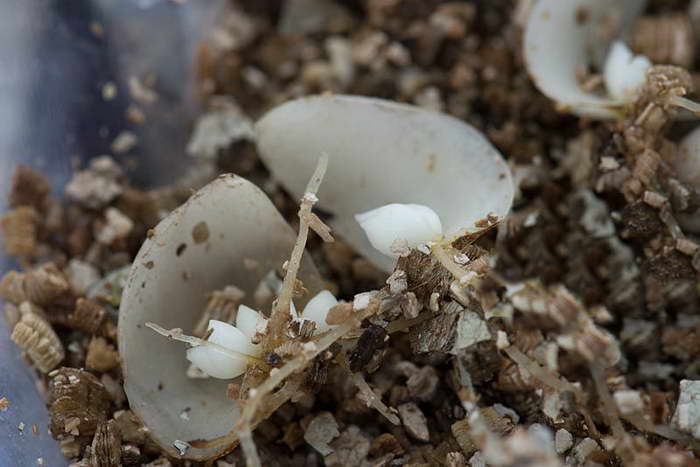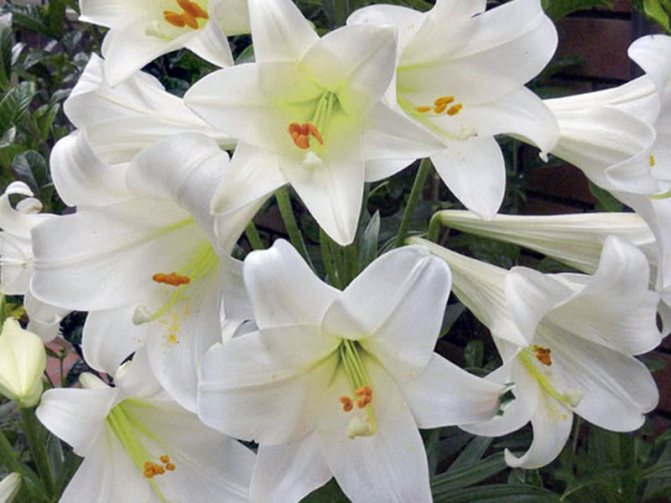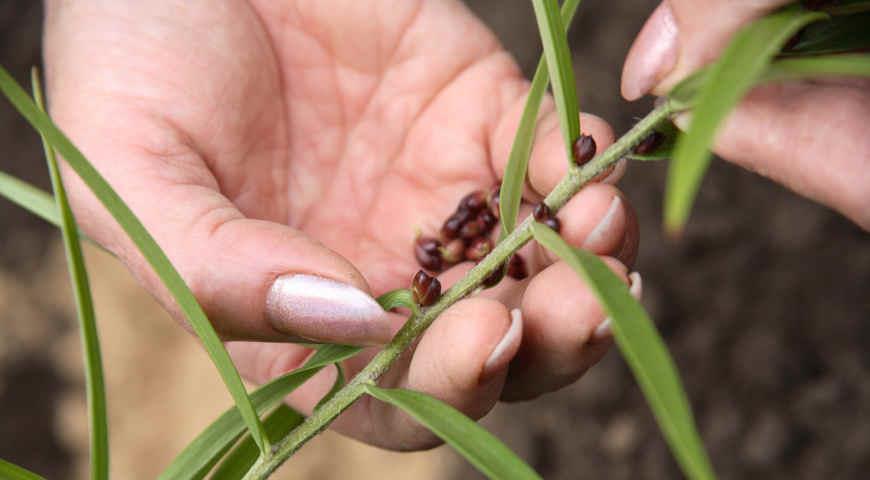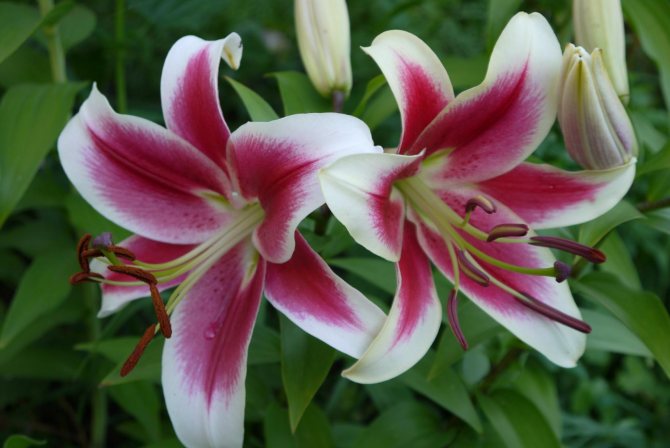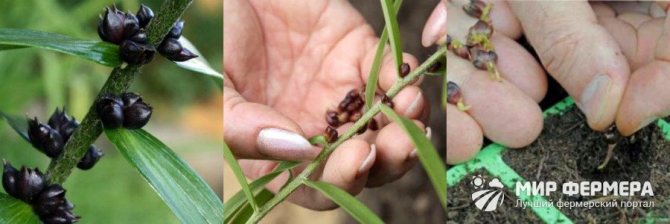Lily is a wonderful flowering plant, the variety of its species and shades is amazing. Not least because of this, it has become so popular among amateur flower growers. Lily can be found in almost every garden, personal plot and even in urban public spaces (parks and squares). Naturally, every grower seeks to propagate this beauty, it is not difficult, since there are many ways for this that do not require any special skills or financial costs.
The benefits of breeding lilies in the fall
Reproduction of lilies, planting them and caring for flowers in the fall has a lot of positive aspects.
- Availability of planting material. It is by the fall that seeds, bulbs ripen, children appear.
- The bulbs are immersed in a dormant state, which means that you can work with them without fear of damaging the root system.
- In autumn, tubers accumulate the maximum amount of nutrients, which significantly increases the vitality and immunity of plants.
- Favorable conditions with an abundance of moisture and cool weather contribute to the rapid establishment of flowers.
- When lilies are planted in the fall, in most cases, flowering occurs next summer.
- More free time for gardeners than in the spring.
.
With the arrival of spring and the beginning of active work on the site, it is difficult to find time for thorough preparation for the reproduction of lilies. The dormant period of the bulbs is short. And if you miss the right moment, the sprouted sprouts may die during recurrent frosts.
When to share lilies
Dividing the bulbous nest is the most common and unpretentious way of breeding lilies. In addition, it is the most natural, since the relatives of cultivated varieties in the wild reproduce mainly in this way.
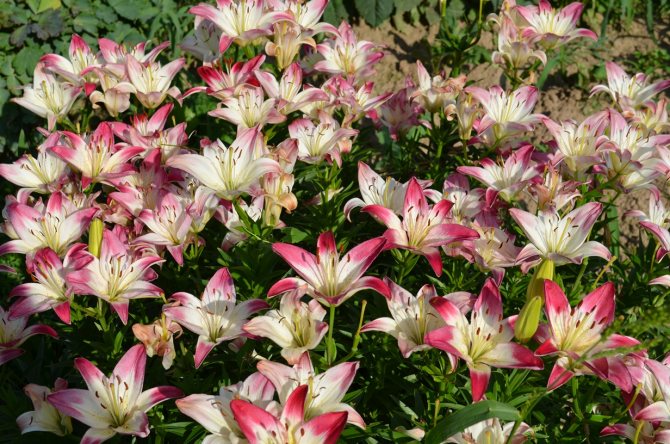
When to share lilies
Garden lily flowers: planting and care, reproduction
The lily bulb is the most important part of it, which provides both plant nutrition and reproduction. Each year, the mother bulb forms daughter bulbs, which, in turn, independently acquire a root system and form new stems. Thus, a so-called "nest" is formed, by dividing it you can get new plants.
Note! You can get new bulbs from one plant only 3-4 years after planting.
When are lilies divided? This can be done about a month after they bloom. In the conditions of central Russia, most varieties begin to bloom in early July and ends in early September. The division of lily flowers in August is possible, but applicable only to some species. However, these are approximate dates, which, in fact, depend on the characteristics of the climate, weather conditions in a particular year, the age of the plants, the type of soil, etc.
One way or another, it is impossible to divide the lily during the flowering period. You should not do this immediately after it.
Breeding methods
There are several ways to breed lilies in the fall. Among them it is worth noting.
- Dividing bulb nests. A reliable, but unproductive method that allows you to get ready-made planting material. Young plants will delight with flowering next year.However, reproduction of lilies by bulbs in autumn is only available 3-5 years after planting. The period depends on the variety.
- Reproduction by near-stem babies is also popular with flower growers. The number of bulbs is greater than in the first case, you can choose them already 2 years after planting. You may need to grow your bulbs in a separate bed over the next summer.
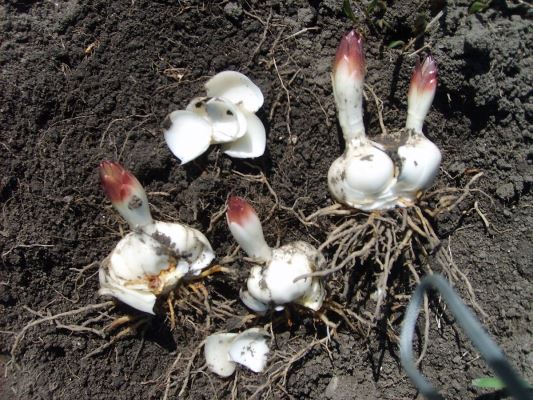

- Reproduction by scales involves the cultivation of bulbs on tuber scales. The method is good in that a lot of seed is immediately obtained.
- Propagating lilies in autumn with bulbs that form in the leaf axils is quite laborious and not suitable for all varieties.
- Planting seeds involves growing them separately for 3-5 years. During this time, the plants will not bloom. But you can get a large number of tubers at a time.
Each grower chooses the methods of breeding lilies for himself. The choice depends on his desire, availability of free time and space on the site.
.
Reproduction methods
Naturally, the question arises - how and when to propagate garden lilies in order to increase the number of beautiful flowers. To do this, there are many vegetative ways for every taste and time of the year. In addition, the seed method is also used.
Scales
Lilies develop from bulbs that are composed of many scales. Any of them is capable of forming new bulbs that appear at its base when favorable conditions are created.
This method is very convenient and economical, since from one large onion, you can get about 20 new full-fledged plants
.
The method can be used throughout the year, but it is more logical and more convenient to use it in the fall when breeding and transplanting lilies or in the spring when planting new bulbs.
The method is suitable for reproduction of any species and varieties of lilies. The disadvantages include the duration of plant cultivation. For, it will take about 3 years to get a full blooming lily.
Step-by-step instruction:
- If the bulb is dug out of the ground, it must be cleaned of dirt. For this, the material must be rinsed in cool water and dried.
- Gently separate the outer scales with your fingers, applying just a little pressure. In order for the donor bulb to survive, more than half of the planting material should not be taken.
- Plant a large lily bulb back into the soil or store it in sawdust or crushed charcoal and place in a dark place with a temperature of no more than 5 °.
- Examine the received scales, reject damaged and diseased ones.
- Rinse good healthy ones and place in a solution of potassium permanganate of medium concentration (about 0.2-0.4 g per liter of cool water). A fungicidal solution can be used instead. Leave alone for half an hour.
- If you want to increase the speed and germination rate, let the scales stand for 12-15 hours in a growth stimulator - succinic acid, epine or zircon.
- Dry the planting material.
- Prepare the substrate. For cold storage, you can use sawdust, moss, a mixture of perlite and peat, fine charcoal. Peat and sand are used for germination in the greenhouse.
- Place the scales inside the substrate. Further actions depend on which germination method is used.
Cold way


The substrate and flakes are placed in a polyethylene bag and stored for about 6 weeks at a temperature of 21-25 °.
Then the package is moved to colder conditions, where the temperature does not rise above 16-17 °. Leave for 4 weeks.
Usually, after this, the scales form bulbs, which must be stored before planting in a cold place (temperature within 2-4 °).
You can put the bag in the refrigerator or cellar and leave it until planting. It is produced in the spring in a planting bed, not earlier than mid-May.
Warm way
Place the substrate in boxes and bury the scales in it.Moisten well and cover with plastic wrap, thin glass or a thick layer of sphagnum moss. Put boxes in a greenhouse. Bulbs appear after a few months. When they release green leaves, you can transplant them outside.
Bulb
Some varieties of lilies, such as Asiatic, tiger and tubular, produce buds or stem bulbs.
They form in the leaf axils, develop during the flowering period, and disappear after ripening. While the bulb is growing, it releases air roots and sometimes leaves. They are best harvested in September or August, when the bulbs have already formed.
The presence of roots guarantees the rapid emergence of new plants. The answer to the question: when to plant lilies with bulbs is extremely simple. They are ready to plant when they are easily detached from the stem.
Disadvantages of the method:
- the duration of the cultivation. Most often, lilies obtained from buds bloom only in the third year;
- the size and amount of planting material depends on many factors; under unfavorable conditions it can be of poor quality;
- bulbs cannot be stored for a long time. They should be planted immediately after harvest. The only way to preserve the airy bulbs for a short time is to place them in the refrigerator, after mixing them with moistened moss.
There are two options for how to grow lilies from bulbs:
Planting in open soil
Step-by-step instruction:
- Prepare a bed for disembarkation.
- Collect the bulbs.
- Plant them in the soil at a distance of 4-6 cm from each other and to a depth of 2-4 cm.
- Bury the planting material and water well.
- Cover with mulch made from vegetable humus, sawdust or peat chips.
- Before the onset of frost, cover the bed with spruce branches or lutrasil-type material.
Landing in boxes
Step-by-step instruction:
- Prepare a nutritious light substrate from garden soil, humus and loosening agents.
- Place the bulbs in it, maintaining a distance of about 3-4 cm, sprinkle with soil on top.
- Place the boxes in a cold greenhouse or greenhouse to keep them intact until spring.
- In the spring, transplant the lily bulbs into the garden garden using the first method.
Children
Daughter bulbs appear on the part of the stem that is located underground. They are easy to reach and transplant without even digging up the plant.
The deeper the mother's bulb is, the more babies it forms. Also, the amount depends on the type and variety of lilies. The saffron, white, golden, long-flowered and umbrella varieties have the greatest tendency to release babies.
ATTENTION!
This method is very easy and fast, does not require any expenses. It is used in early autumn, after active seasonal vegetation.
Step-by-step instruction:
- Carefully excavate the lily, exposing the upper underground part.
- Separate all daughter bulbs, taking care not to damage the integrity of the skin.
- Prepare a seedbed with light nutritious soil.
- Plant the children into it, deepening it by 2-3 cm.The distance between the bulbs should be at least 4-5 cm.
- Water, mulch.
- For the winter, cover with leaves, spruce branches or covering material.
ATTENTION!
To activate the formation of daughter bulbs, you can remove the buds without letting the lily bloom.
Decapitation will not only allow you to get a large number of high-quality babies, but also accelerate the development of a large bulb.
Bulbs
The easiest way
which is applied in the fall or spring. If an adult lily has been growing for 3-5 years, it begins to form new bulbs under the main one. They can be detached from the plant and planted separately.
The only drawback of this method is that usually very few bulbs are obtained.
, depending on the type from 1-2 to 5-6 pieces.
Step-by-step instruction:
- Dig up the plant, shake off the soil and inspect. In the spring, you can only pull out lilies, the height of which is no more than 8-9 cm.Otherwise, they will hurt for a long time after transplanting
- Separate all formed bulbs together with the stems from the mother.
- Plant them in the chosen place, taking into account the size. Large bulbs can bloom this season.
- If it is not possible to immediately plant the bulbs, they can be stored in a moist substrate of sand, moss, peat, perlite, or simply buried in the soil.
Seeds
Certain types of lilies are fast-growing
(Daurian, drooping, Regale, long-flowered, narrow-leaved, golden, luxurious).
Such varieties form bolls.
filled with many seeds. Once ripe, they can be harvested and used to grow seedlings.
IMPORTANT!
The method is quite laborious, but you can get a lot of plants at once. Reproduction of lilies in autumn by seeds in the ground
IMPOSSIBLE
... Seeds are sown in February in order to get seedlings by spring.
Step-by-step instruction:
- Place light breathable soil in prepared boxes.
- Make grooves 8-10 mm deep, sow seeds evenly and cover them with soil.
- Moisten with a watering can or spray bottle, cover with plastic wrap or glass.
- Place in a warm room and spray occasionally with water.
- After germination, remove the film, move the box to a cooler place with a temperature of no more than 15 °.
- When the first leaf is formed, increase the temperature to 19-21 °.
- If necessary, plantings are thinned out.
- At the end of May, strong shoots are planted outside for further development. The weak are placed in a greenhouse until next season.
ATTENTION!
Rarer methods, which are used only in the absence of other planting material, include propagation by cuttings after flowering and by leaves.
Cuttings are cut at the budding stage, dividing the stem into pieces of 6-8 cm. Unnecessary leaves are removed from them and planted at an angle into an air-permeable substrate.
A greenhouse effect, constant humidity and shade are required. Under favorable conditions, after 4-5 weeks, the formation of bulbs in the leaf sinuses is possible.
For leaf propagation with a sharp knife, cut off the leaf together with a part of the stem (heel) and carry out the same actions as for grafting.
You can listen to tips for breeding lilies in this video:
With proper care, the bulb will appear at the base of the leaf. The method is suitable for breeding species that form airy stem bulbs.
Reproduction of lilies is a fun creative process
, pleasing with its wonderful end result. What could be more interesting than developing a beautiful flower from a small bud or seed? Growing lilies on your own makes it possible to admire the entire process of their growth from start to finish.
The method is used when transplanting lilies.
After 4-5 years after planting a flower, it becomes necessary to transplant it.
More precisely, this process can be called seating, since nests consisting of 4-6 bulbs are formed underground during growth.
The dug nest must be divided, otherwise the lily will stop flowering.
The plant is dug out of the ground at the end of September. The formed bulbs are separated, treated with a solution of potassium permanganate, dried in the shade.
The roots of the bulbs should be cut 8-10 cm.
IMPORTANT:
Do not expose the bulbs to dry in the sun; they will burn and dry out.
After drying, each onion is planted in a separate hole. Already in the second year after division, each specimen will bloom. If the formed bulbs are small, then flowering will begin in a year.
Children
At the base of the lily stem, small baby bulbs are formed.
If the bulb is planted deeply, the number of babies will be quite large.
If it is necessary to reproduce a variety growing on your site, you can artificially increase the number of such bulbs.
To do this, flowers are removed from the lily, preventing them from blooming. You can also separate the stem with the formed babies in the spring and dig it in the shade.
TIP:
In order for the plant to take root, it is watered abundantly. With this technique, a large bulb is formed on the stem by the fall.
Bulb
This material forms between the stem and the leaves of the lily. They should be collected immediately after flowering.
Propagation of lilies by bulbs is a simple way that you can get a large number of seedlings.
Each flower can form from 100 to 150 air bulbs, each of which is capable of giving life to a new plant.
IMPORTANT:
Bulbules are planted in pots and kept at home. In spring, the sprouts from the bulbs are planted in the ground at a distance of 6-7 cm from each other.
Scales
Lily bulbs have one feature - they are covered with scales, on which you can grow small bulbs - babies.
You can get scales from a bulb when you transplant a plant. The grooves for planting are located at 20-25 cm.
From the onion dug out of the ground, the scales are carefully separated, washed in a solution of potassium permanganate and treated with a fungicide.
Then the flakes are placed in an opaque bag, sprinkled with peat or sawdust. The bag is placed in a warm room for 8-7 weeks. Then for 4 weeks the temperature is reduced to 17-18 degrees.
During this time, 3-4 new bulbs are formed on each scale. Thus, one mother bulb can produce 20 to 100 new plants.
The formed bulbs are planted in the ground in the spring, by which time they are ready for growing in the open field.
IMPORTANT:
Flowering of such specimens will begin in 3-4 years.
Cuttings
Especially valuable and rare varieties of lilies can be propagated by cuttings. Stems and leaves are suitable for their production.
Stem cuttings. Harvested before the start of bud formation. The stem is cut from the plant and cut into 8-9 cm pieces.
The cuts are made at an angle and the workpieces are placed obliquely in the ground to the level of the upper leaves.
The plantings are watered regularly. After 1-1.5 months, depending on the air temperature, bulbs appear in the axils of the leaves. They can be separated and planted in the soil.
TIP:
To increase the number of bulbs on the stem, shallow cuts are made on it in the underground part.
A leafy cutting with a small piece of stem is also suitable for propagation. Before flowering, it is cut from the plant and placed in a container filled with soil.
From above, the handle is covered with a transparent cap. Rooting takes place within 4-5 weeks. As soon as the first shoots appear on it, the workpiece can be moved into open ground.
IMPORTANT:
Lilies obtained from cuttings bloom in the third year.
Seed method
Separately, it should be said about obtaining lilies from seeds. Seed propagation of lilies is suitable for obtaining new varieties on your site.
In addition, this is the most productive method, it allows you to get many copies of plants at the same time.
Another plus is the resistance of the grown flowers to diseases, since viruses are not transmitted through the seeds.
The seed method is the only one for breeding lilies of hybrid varieties, since the resulting bulbs do not retain the properties of the mother bulb.
TIP:
When choosing seeds before buying, make sure they are fresh, as already in the second year after harvesting, germination may decrease by 50%. In the third year, only 5-10% are able to germinate.
If you want to get seeds from specimens growing on your plots, it is worth learning about the pollination ability of your growing variety. There are self-pollinated and artificially pollinated species.
It is also worth observing the seed collection technology.You can not pluck the boxes until the seeds are ripe. At the same time, if you are late in collecting, the capsules may open and the seeds will spill out onto the ground.
A healthy stem is selected for collection. It is necessary to cut it before the onset of frost. The stem with seed pods is placed on paper and left to dry completely.
If frosts have already come, and the boxes are not ripe, the stem is separated from the bulb and placed in a vase with sugar water (a teaspoon per 1 liter). In such conditions, the seeds will ripen.
IMPORTANT:
When separating, you need to try to keep a certain number of roots on the stem in order to ensure its further nutrition.
Before sowing, the seeds are prepared in a special way to improve their germination. After separation from the box, they are mixed with sand and placed in a refrigerator.
Sowing seeds is done in three ways.
In open ground
This method is suitable for frost-resistant varieties.
You should choose a site where bulbous crops have not previously been grown.
The site should not be flooded with melt water in spring, and the place should be as sunny as possible.
The soil is dug up, freed from plant residues. Heavy soils need to be supplemented with peat and sand for breathability.
The ridges are made high, one meter wide. On the beds, transverse grooves are made at a distance of 15-20 cm from each other. Seeds are placed in the grooves 2-3 cm deep and covered with a layer of sand. From above, the crops are mulched with a layer of humus and foliage.
IMPORTANT:
Growing seedlings takes place at this place for two years, after which the plants can be planted in flower beds.
In seedling boxes
Rare varieties of lilies should be sown in boxes of potting soil and grown in greenhouse conditions.
The substrate is prepared from a mixture of peat, turf and fine gravel. Seeds are scattered randomly over the surface and sprinkled with a layer of sand.
Germination temperature - 18-25 degrees. If the temperature is higher, germination is sharply reduced. Seedlings appear in 15-25 days.
As soon as the first shoots appear, you need to make sure that they do not die from the sun and lack of moisture. Lily shoots are most vulnerable at this moment. The temperature at this time should be lowered to 15-16 degrees.
In the phase of a real leaf, the seedlings dive, trying not to damage the delicate roots. After picking, caring for the sprouts consists of watering and protecting them from pests.
TIP:
To prevent fungal diseases, the sprouts are sprayed with Bordeaux liquid, and chlorophos is protected from aphids.
In jars with a nutrient substrate
This method is used for poorly germinating varieties.
To do this, peat and sand are mixed in equal amounts, moistened and filled with the mixture in a glass jar.
Seeds are placed in the substrate, the jar is covered with plastic wrap and tied to fix it with an elastic band or thread.
Banks are placed in a warm, bright place. The temperature is maintained around 18-20 degrees.
After 60-90 days, bulbs grow in the jar. As soon as they become visible through the walls of the cans, the mixture, together with the bulbs, is poured into plastic bags and placed in the refrigerator.
In this state, the bulbs are stored for 2 months. After this period, the bulbs are selected from the soil and planted in seedling boxes.
Onions grown from seeds are planted in open ground in September. Varieties with low frost resistance are grown in boxes until spring.
Lilies grown in this way begin to bloom in the second year.
Regardless of the method you choose for breeding lilies, this is not very difficult to do. Every florist, even an inexperienced one, will cope with the process and will be able to get new copies of a beautiful flower for his site.
How to propagate lilies in autumn with scales
The lily bulb is covered with a large number of peculiar fleshy petals, the number of which increases every year. It is their growers who call them scales. To plant scales in the fall, you need to do the following:
- With the help of a pitchfork, the tubers are dug out, trying not to damage them.
- Healthy, intact scales are carefully separated. Experienced growers do not recommend removing more than a third of the petals. This threatens the death of the uterine bulb.
- The flakes are washed in running water.
- Soak for 30-40 minutes in a weak solution of manganese potassium, and then for another half hour in a solution of a growth stimulator. It is advisable to use the one that affects the development of the root system, "Kornevin" or "Zircon".
- The planting material is layered in a bag filled with wet peat, moss or sawdust, and placed in a refrigerator for 2-3 weeks.
- With the appearance of roots, scales with rudiments of small onions are planted in the ground on a separate bed, deepening them by 2-3 cm. The lilies will be ready for transplantation to a permanent place in a year.
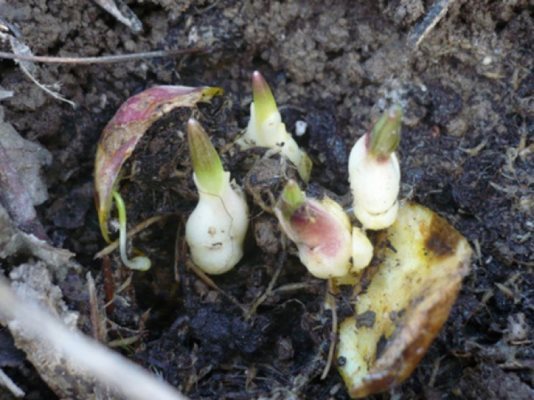

Attention!
Flakes should be planted in the fall no later than 3-4 weeks before the onset of cold weather.
Be sure to cover the plantings with spruce branches or mulch with a mixture of peat and sawdust. If the frosts were established earlier or the winters in the region are cold, then the planting material is stored in the refrigerator until spring, periodically moistening.
The author of the video will tell about the reproduction of lilies by scales in the fall
How to breed lilies at home
For those flower growers who do not have a summer cottage or a personal plot, there is also the opportunity to enjoy lily flowers by growing it at home. For this, the most ordinary indoor pot is suitable. But how to propagate lilies in such a case?
Reproduction of lilies at home is also possible and three methods are used for this:
- planting seeds;
- cuttings;
- bulbous way.
The latter is the most appropriate in this case. Bulbs obtained by dividing should be carefully examined for rot and disease. Then, after soaking them in a solution of potassium permanganate (no more than half an hour), they are stored in a cold, dark place, periodically airing and checking. In February or March, the bulbs can be planted in a pot.
There are many ways to propagate lilies and they do not present any particular difficulties both for an experienced grower and for beginners, for whom growing lilies is the first such experience.
Reproduction of lilies by bulbs in autumn
Air bulbs are not formed in all varieties. This occurs most often in Asiatic, tiger and tubular lily species. Most likely, modern hybrids cannot be propagated in this way.
.
A bulb is a small pea or bean that is brown or brown in color. It appears on the aerial part of the plant at the end of summer. This is practically the same baby. It ripens in early autumn. At this point, the seeds are easily separated from the stem. If you look closely at them, you will notice small roots, or even the leaves that have turned up.
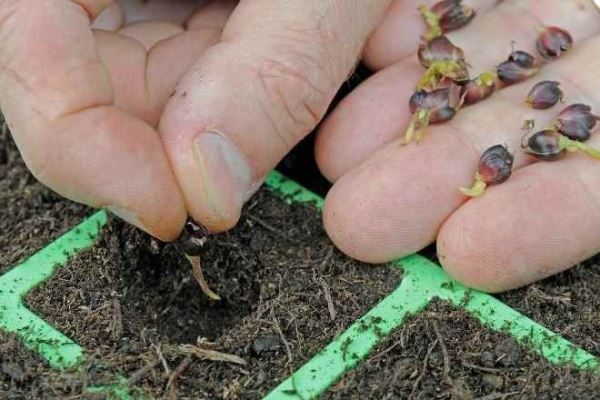

Depending on the weather conditions, the collected bulbs can be:
- immediately land on the prepared ridges, and cover them for the winter;
- plant in containers and store until spring in a dark, cool room;
- put in storage until spring in the refrigerator, sprinkled with sawdust or moss.
Attention!
Strong lily bulbs, ready for transplanting to a permanent place, will be ready for flowering no earlier than 2-3 years after planting.
More information about the propagation of lilies by bulbs in autumn can be found in the video
Features of reproduction and transplantation in autumn and summer
How are lilies propagated and when can they be transplanted? An adult garden plant for its normal growth and reproduction must be transplanted regularly about once every 2-3 years. In our climatic conditions, typical of central Russia, this procedure should be carried out in the fall. It is at this time of the year that a plant that has already bloomed is in a state of vegetative dormancy, so the risk of harming it during transplantation and collection of daughter bulbs for reproduction is minimal.
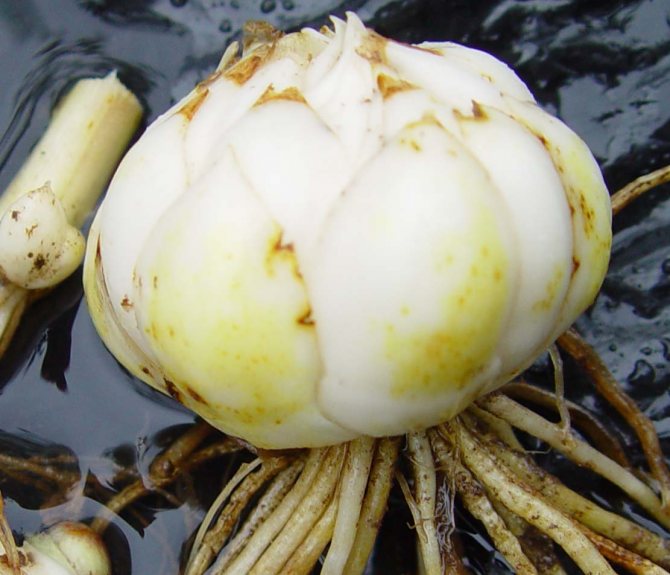

Bulb propagation
However, one should not wait for the first cold weather.If by the time of transplanting the temperature on the soil crosses the minus mark, then there is a risk that the bulb may freeze over, and the plant itself will not multiply. Therefore, the most optimal month for this is September. In more northern regions, it is possible to replant lilies at the end of August.
You should not transplant and cultivate these plants during the height of summer - the peak growing season. However, there are some varieties in which the resting time, on the contrary, falls in the middle of the warm season. For example, this applies to the popular Candidum variety, as well as tubular and oriental hybrid species. They should be transplanted very carefully, trying not to damage the root part. After planting in a new place, the buds and flowers should be cut off from the plant for more lush flowering next year.
How to plant lily babies in the fall
Reproduction of lilies by children in the fall is generally similar to planting them. Babies are formed above the uterine bulb on the underground part of the stem.
A site is preliminarily prepared for planting large specimens in a permanent place and a small bed for small tubers. The soil is dug up, compost and potassium-phosphorus fertilizers are applied.
.
- The bulbs are either carefully dug up with a pitchfork, or the stems are dug in to gain access to the babies. The second method is less traumatic, but not always available, so lilies in the process of growth can deepen or go to the side.
- The separated bulbs are examined. Cull out damaged or with signs of disease.
- Soak in fungicide solution. You can use Fitosporin or Topaz.


- I plant large tubers in prepared holes to a depth of 15-20 cm. It is advisable to plant them on sand or sawdust. They are covered with soil, watered and mulched.
- Small bulbs, if desired, can be planted in a separate bed for one year. They are deepened by 4-6 cm. The plantings are also watered and mulched.
Large bulbs are likely to flower the next year. Possibly small ones too. But it is better to remove them so that the tuber itself gains strength.
More information about the reproduction of lilies by children in the fall can be found in the video
The second way - with onion-babies
At the base of the lily stem, baby bulbs are formed, the number of which depends on how deeply the bulb itself is planted. It goes without saying that the deeper the landing, the greater the number of children formed.
Most of the varieties of lilies can be easily propagated by stem baby bulbs.
In order to increase the multiplication factor with this method, I recommend decapitation or, in other words, the removal of buds. Decapitation will lead to an increase in the bulb itself and the formation of children.
And you can act even more radically: after decapitation, carefully separate the stem with supra-lucid roots from the bulb, plant it in the shade and water it abundantly. And on the underground part of the stem, by the fall, we have a very large baby.
Reproduction of lilies by cuttings in autumn
Reproduction or transplantation of lilies in the fall to another place, some growers perform cuttings. The method is rather risky. But what if the variety does not form bulbs and weakly forms children.
In this case, the main thing is not to miss the right moment, since you need to use more green cuttings of completely faded lilies.
.
- 7-10 days after the petals fall off, the seed boxes and the stem itself are cut off at a height of 10-15 cm from the soil surface.
- Sections are treated with potassium manganese solution.
- Planted in sand or coconut fiber in containers. Can be planted in a greenhouse. Long cuttings are planted at an angle.
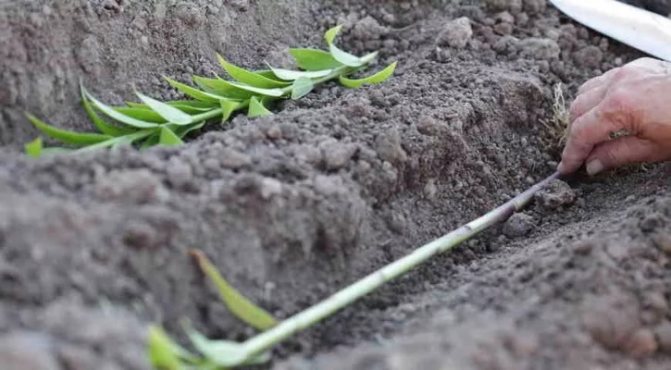

- Plantings are abundantly watered and covered with foil.
- Make sure that the soil is constantly wet.
- After 1-1.5 months, children should form, which are planted on a separate bed for growing.
Attention!
It should be borne in mind that cutting the lily stem in the fall before it dries completely harms the bulb.Having lost the aboveground, green part, the plant may not have time to stock up on nutrients before the onset of cold weather.
.
The third way - with scales of bulbs
Each scale of a lily bulb is capable of forming new bulbs at its base. The third method of reproduction of lilies is based on these properties.
This is the method with the highest reproduction rate, since from 1 to 3-4 bulbs are formed on each scale, which means that from 1 adult bulb there is an opportunity to get 15-150 new plants.
In time, it takes 2-3 years - this is the period from the moment the scales detach to the development of an adult plant. Lilies can be propagated in this way throughout the year, but still the best time for this is spring (the beginning of the growing season) and autumn - the period of digging and replanting, and even later, before the soil freezes.
So what are our actions with this method of reproduction:
- We wash the dug out onion, press the fingers to separate it at the base of the scales. For reproduction, we take from 1/3 to ½ of the bulb, since the outer scales are more productive. The rest of the central part of the bulb can be planted in the ground.
- For reproduction, we choose healthy, large scales and without spots.
- Then the scales are thoroughly washed in water and kept in a dark pink solution of potassium permanganate or a solution of any fungicide for 20-30 minutes.
- In order to increase the multiplication factor, the scales can be additionally kept in a solution of zircon, epin or succinic acid for 12-16 hours.
- Next, dry the scales slightly and place them in small plastic bags, sprinkling them with a substrate (perlite, sphagnum moss) or sand. You can even just put the scales in bags without sprinkling anything.
- We tie the bags with scales tightly and put them in storage in a dark place for 6-7 weeks. The temperature should be 22-23 o C.
- After that, for another 4 weeks during storage, it is necessary to maintain a temperature of 17-18 ° C.
- The scales with small bulbs appearing at the base are now ready for planting. If it is not immediately possible to disembark, then before planting we store them at a temperature of 4 o C.
- Those scales that we removed in the fall will be ready for planting in boxes in a greenhouse or in another bright room in February-March. And then we plant the seedlings in the ground in May-June.
- If we were breeding in the spring, then the bulbs, together with the scales, can be immediately planted in open ground.
When lilies reproduce by scales, about 50% of the plants bloom already in the 2nd year after planting.
Reproduction of lilies by seeds in autumn
Seed propagation of lilies is a troublesome task that is not suitable for every grower. Basically, it is used for breeding new varieties or breeding rare varietal lilies.
In autumn, brown seed bolls are collected from the plants. The seeds are planted in containers filled with nutrient soil. In spring, the emerged plants dive into the ridges.
The main disadvantage of this method is that at least 5 years pass from the moment of emergence to the first flowering.
How to keep lily bulbs
Carefully remove the ripe bulbs from the lily stem, being careful not to damage the resulting root and not destroying the integrity of the mini-scales. Wrap the bulbs in sphagnum moss and seal them in a plastic bag. Packages with bulbs will be perfectly stored in the refrigerator at a temperature of 0-3 degrees Celsius until spring. In the spring, as soon as the soil thaws, boldly plant the bulbs in open ground to a depth of at least 5 cm.
How else can you quickly propagate your favorite Asian lily hybrid variety?
I will advise you an agrotechnical method for the rapid reproduction of lilies. In the photo, you see young bulbs with leaves formed on a lily stem bent to the ground. In order for the stem bulbs to form more intensively, remove all the buds from the inflorescence on the stem so that the plant does not spend a lot of energy on flowering.At the end of summer, after the foliage on the stem withers, shorten the stem with new bulbs to the level of the ground surface and cover with a thick layer of fertile soil so that the young bulbs do not suffer from winter frosts.
If you want to know what an adult lily bulb with roots looks like, a description of the life cycle of a lily bulb: winter - the bulb is at rest, spring - the beginning of the growing season and the appearance of the first shoots, summer - active flowering of the bulb, autumn - the accumulation of nutrients in the bulb after flowering , read our helpful tips in the article
How to make the lily bulbs bloom in the first season? I will definitely share all the secrets with you in the next article. I wish you a beautiful blooming lily garden!
Best regards, Nelly "Nelly Grigorieva's Landscape Workshop"
As I promised, in this article I want to invite you to familiarize yourself with several of the most common ways lily breeding
... Lilies can be propagated both by seed and vegetatively.
Reproduction of lilies
seeds are more complex and troublesome, it is usually used by breeders when developing new varieties.
And among amateur flower growers, vegetative propagation methods are more common. Let's take a look at them.
Planting care
Taking care of transplanted flowers in autumn is a snap. Most often, they need watering and shelter for the winter. Lilies propagated by separating children do not need watering.
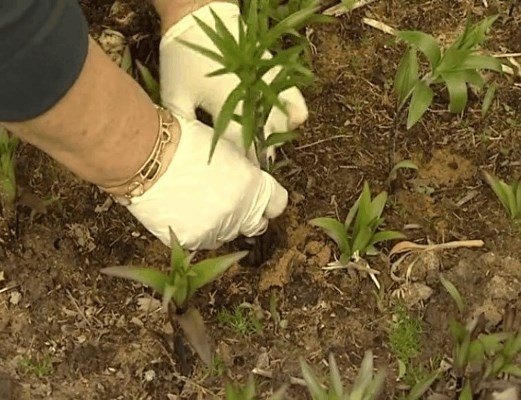

For the winter, the ridges are covered with a layer of sawdust or pine needles mulch, or covered with spruce branches. In regions with cold, but little snowy winters, you can additionally close the plantings with agrofibre.
Bulb dilution
Just plant lilies with bulbs. Here, too, you need to follow the recommendations of experienced gardeners and there will be no problems when growing flowers.


Nuances
Asian hybrids have bulbous stems. They can be plucked and used as seed.
There are more or less of them and they are different in size. Why is that? It depends on the variety of lilies, how old are the flowers, in what climatic zone do they grow, how were the plants looked after?
If the flower care is excellent, then even when the bulbs grow on the stem, they start up roots. It is not difficult to grow them in water and can be planted.
Coaching
In order not to confuse anything, a beginner should follow clear step-by-step instructions. Experienced gardeners know these nuances and adhere to the recommendations of specialists.
If a gardener wants to breed lilies with bulbs, he must act like this:
- The lily will fade and drop the bulbs. They need to be collected in a polyethylene bag.
- The packed seed is placed on the lower shelf of the refrigerator. Where vegetables are kept. Soon they will sprout roots and be ready for sowing.
- You need to select a bed and plant bulbs there in order to get seedlings.
- It is best when the soil is light and saturated with trace elements.
- Furrows are drawn and bulbs are inserted there 2 or 3 cm deep. One deviates from one by 5 or 6 cm.
Bulb care is similar to flower bulb care. These lilies can be planted in a common flower garden next spring.
The video describes how to successfully propagate lilies with bulbs:
Site preparation
To ensure healthy growth and lush flowering, the preparation of the site must be done in advance. Do this a month before planting (planning to plant in early spring - fall).
For digging to a depth of 35-40 cm, add (per 1 m² of area):
- 1 bucket of rotted manure, compost or humus (the introduction of fresh organic matter is unacceptable - the bulbs will rot);
- 1-2 tbsp. spoons of superphosphate, urea, nitroammophoska;
- 1 liter of wood ash solution (with the exception of planting candidum and marchon lilies).
Seeds


This method is also possible, but of all the ones presented in the article, it is the longest and most labor-intensive.In addition, varietal characteristics may not be preserved - there is such a risk. It is better not to propagate hybrids and varietal lilies by seeds, but you can try with specific specimens.
For reproduction, fresh seeds collected with your own hands are better suited than purchased ones. Seeds of Asiatic lilies sprout the fastest, and curly lilies the longest. The collection of seeds takes place in the summer, when the capsule turns dark and turns brown. Sowing is carried out in moistened peat or vermiculite: in time it is worth choosing February, and the degree of depth of seeds is no more than 1 centimeter.
A container is kept in the refrigerator until the seeds hatch, then they are transplanted into pots with soil. Germination takes place at room temperature under a film. When the shoots appear, the temperature must be lowered to +15 degrees, and with the appearance of the first leaf, it must be raised again to +20 degrees. It is unacceptable to overmoisten the seedlings, although watering should be done regularly.
In April, take the container with seedlings to the greenhouse and dig into the garden bed. If there is no greenhouse, you can get by with a sunny balcony, veranda, window sill.
When the seedlings are strong, they can be planted in the garden. This usually happens in May. It is necessary to shade young plants from the intense sun. Water the seedlings regularly and spray them every week with potassium permanganate (0.15%) against diseases and pests.
In this case, it will take the longest to wait for the lilies to bloom: from five to eight years. Due to such exceptional time costs, the method is extremely rarely used in amateur floriculture. At home, seeds can only be propagated by fast-growing types of lilies: Golden, Regale, Long-colored, Narrow-leaved, Luxurious. And even that time from planting to flowering will take quite a lot.
Getting new lily plants from a flower shoot
The most interesting thing is that lilies can also be propagated by cuttings after flowering. Moreover, you can try to use this method to propagate lilies from a bouquet that was presented to you for any celebration.


After the end of the flowering of the lily in your garden, completely cut off its peduncle along with the leaves (a stump, 15-20 cm in size, it is better to leave it so as not to forget about the place of planting the bulb) or take a flower shoot from a wilted bouquet.
In a shady place of the site, pull out a small groove, about 2 cm deep, and a length equal to the length of the cut shoot. The soil should be loose, light, but quite nutritious. Lay the lily flower shoot horizontally in this groove and cover it with a light, loose earth mixture on top. Then spill everything abundantly with a stimulant solution (Epin, HB-101, Zircon, succinic acid). It is better if it is possible to cover the landing site with film or lutrasil on small arcs. After two months, small bulbs should form on the stem, which are best left untouched until next spring. For the winter, mulch the planting site abundantly with peat, humus or sawdust.
Attention! If you do not have a plot of land, then lily propagation by cuttings can be carried out at home, using a large long container, but for the winter it is better to place it in a cool, but frost-free room.
The next spring, the bulbs can already be planted in a permanent place in the garden or in containers for growing in a greenhouse or on a balcony.
Reproduction of lilies in the spring by preparing the bottom of the bulb
There is another rather exotic way of breeding lilies. In the spring, the bottom of a large bulb is carefully cut out, and then it is planted in the ground with the crown down, and the lower part without the bottom should be at the top. In the summer, the bulb will only need watering; when winter comes, the planting must be well insulated.
In the spring, all the bulbs formed by this time should be planted in the growing garden. True, the mother bulb dies as a result.But the number of children obtained is several times higher than the number that can be obtained from reproduction by scales.
How to care for a garden lily
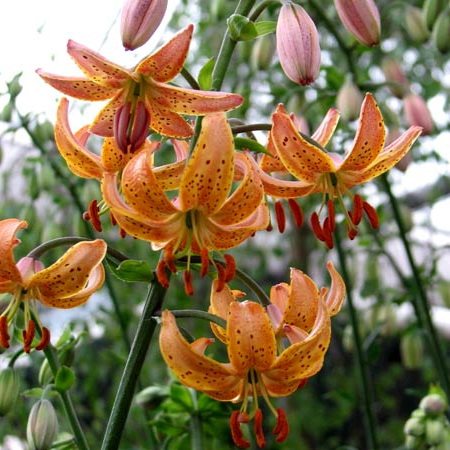

Lily curly martagon photo
The beauty lily is unpretentious in leaving.
Watering and loosening the soil
Provide regular watering. Water most abundantly during the growing season and in hot, dry weather. The soil should be 25-30 cm wet (bulb depth). Avoid waterlogging, the plant will better tolerate short-term drought than excess moisture. On hot days, watering is preferable in the morning or evening. Bring water under the root, trying not to get on the leaves.
Oriental hybrids are especially susceptible to soaking. If the weather is rainy for a long time, such a flower should be covered to protect the bulbs from decay. Air out when the sun comes out.
Remove weeds from the site, periodically loosen the soil.
Mulching with humus or peat will cut the work in half.
Top dressing
It is enough to feed a couple of times a season. Use complex mineral fertilizers. Carry out the first feeding in early spring, the second - at the beginning of flowering (focus on the proportion of potassium and phosphorus).
Pruning and preparing for wintering
After the end of flowering, when the peduncle and leaves are completely dry, cut off the stem, leaving a stump of 15 cm in height.In late autumn (about November), carefully remove it as well - this way, you will limit the access of cold air to the bulbs.
Description of the species
Lily is a bright and versatile plant, the color range of which can range from deep white to deep purple. Breeders have bred several thousand varieties of this beautiful flower. It can be spotted and matte, terry and glossy, monochromatic and decorated with different patterns and designs.
The shape of the flowers is also complex and varied in texture. It can be stellate and flat, turban-shaped and tubular, funnel-shaped and bell-shaped.
Each type of lily differs from each other in the size of flowering. For example, turban lilies vary in diameter between five and ten centimeters, and flat lilies - from twenty to twenty-five centimeters!
Advantages and disadvantages of scale propagation


The reproduction process of lilies by separating the scales from the bulb has many important advantages that can become decisive when choosing the reproduction of a flower you like.
Among them:
- Efficiency.
- The cost-effectiveness of the method.
- A large amount of planting material from one bulb.
- Suitable for almost all types of lilies.
- Ease of implementation.
The disadvantages of the method of reproduction of lilies with scales include:
- There is a chance that not all scales will produce new bulbs.
- If you overdo it with the separation of the scales from the mother bulb, you can damage the adult plant.
- Not all new bulbs are accepted.
- Careful care for new bulbs is necessary until they are strong.
The method of propagation of lilies using scales is most indicated for varieties that form very few daughter bulbs.


Reproduction of lilies by scales separated from the bulb - allows you to get many independent plants that fully inherit all the characteristics of the parent flower. With due patience, and careful execution of all work, it is possible to get a rich flower garden from your favorite lilies.
Care


We will find out what kind of care and conditions must be provided to young lilies after planting, so that they quickly get stronger and bloom.
Lighting
The need for lilies in light largely depends on their type and variety. Such varieties as Tigrovaya, Leuchtlina, Speziosum, oriental and tiger hybrids are quite favorable to light penumbra and areas where the sun is 4-6 hours in the morning or in the evening. Lilies of Asian varieties grow better in the sun, but light partial shade is also acceptable for them.
Garden lilies of tubular varieties, hybrids of OT and LO need a long sunny day.But from the bright midday sun, nevertheless, shading is desirable for them.
Support
If the lily reaches a height of more than half a meter, it must be tied to a support. Otherwise, the stem of the plant may bend or break.
Watering
Lilies love to grow in moderately moist soil. Drying of the soil and excessive moisture are contraindicated for these plants. Try to avoid extremes.
Watering is carried out if necessary. If there is no rain, then the frequency is once a week. Water is introduced strictly under the root and between the rows, avoiding drops on the stems, foliage and buds. The optimal time for moisturizing procedures is in the morning or 14-15 hours in the afternoon: before the night, the soil should dry out on top.
Be careful with watering in spring and autumn when frosts are likely. If the soil does not have time to dry out before nightfall, it is very likely that it will be caught in the frost along with the roots of the lily.
Waterlogging is fraught with fungal diseases for lilies, so it is better to avoid it. After the plants have faded, watering is stopped completely: with the exception of extremely dry weather without rain.
Mulching
After planting lilies, the garden must be mulched. The procedure will remove weeds from the soil and help retain moisture at the roots. Organic materials can be used as mulch: sawdust of coniferous trees, simple needles, peat, straw, fallen leaves.
Gradually, the mulch layer will decompose and serve as a source of additional nutrition for the plants. If you have provided for mulching, you will be spared from loosening the beds after watering.
Top dressing
You can not feed lilies with organic fertilizers: these flowers do not tolerate manure or compost. However, it is permissible to add humus to the soil, but by the time of introduction it should already be pretty rotten, and not fresh. It is also impossible to feed lilies with green fertilizer, consisting of real mowed grass. From organic fertilizers, rotted fallen leaves are acceptable.
So, lilies are fed with minerals:
- in the spring with calcium nitrate (6 g / 1 liter) twice with a two-week interval;
- during bud setting and flowering - with a complex mineral composition (Fertika) or potassium magnesium (30 g / bucket of water) also twice with a two-week interval;
- after flowering with potassium and phosphorus once.
Important: you cannot transplant and feed at the same time.
Shelter
If the winters in the region are harsh, lilies need to be covered for the winter. And the young take refuge without fail, even if we are talking about the southern regions.
To cover the flowers, it is enough to rake the fallen leaves onto the garden bed (perfect from under the fruit trees), and if the winters are very cold, add spruce branches and peat. From rainy, chilly weather, a plastic wrap on top will not hurt either: it must be secured with staples or heavy stones.
Planting lily scales in the ground
There are different recommendations for the preparation and choice of soil in which the lily scales will be placed, but the best option would be to add sand to the soil from the place where new bulbs will have to be planted in the future, the ratio is 1: 2 - 1: 1. The scales can be placed in a box or tray of soil, or they can be placed directly in the soil in a well-shaded area. In the case of planting them in a box, watering will be the main concern; on the ground, pest control will be the main problem. On the ground, the scales are placed in a hole, which will be covered with glass.
The lily scales are buried in the ground by two-thirds, they need to be positioned with a slope, with a concave surface upward. The tip of the scale should at first look out of the soil by at least a quarter. The soil is watered abundantly, if it sags, then the scales need to be slightly deepened. Then the box also needs to be covered with glass.
Further care in the next couple of months is to maintain soil moisture.
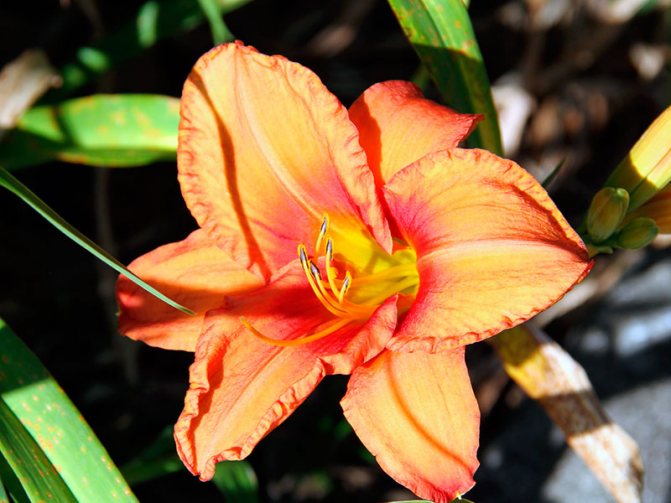

How to care for planted lily scales
After one and a half to two months, new lily bulbs begin to form at the base of the scales, when 3-4 small scales appear on them, and their size almost reaches a centimeter - the first root appears. After the root, the growth of the first leaf can begin, of which there may be several - now you need to pay maximum attention to protecting the leaf from pests: crackling beetles, slugs and snails. If the scales are planted in the ground, you cannot do without chemistry. And you still need to monitor the moisture content of the soil and gradually accustom the leaves to lower humidity, first opening the edge of the glass by a few millimeters, and after a few days - by a couple of centimeters. After a week, the glass is removed. New plants grow in a normal environment. You can gradually start feeding them with fertilizers.
By the end of the season, one or two bulbs up to one and a half centimeters in size will be formed at the base of most of the scales. During the second year, new plants will gain strength and the bulbs can grow up to 3-4 centimeters, and some plants from the new bulbs will even bloom the next year.
When garden lily blooms
The flowering period of the garden lily begins in June and lasts almost until the end of September. It all depends on the following factors: first of all, on the type (variety), the age of the bulbs (young ones may not bloom), the timing of planting, the planting site (sunny area or shading), the climatic conditions of the region (in the southern regions, flowering begins earlier - possibly from the end May).
About varieties:
- The fastest in development are Asian hybrids: the period from the awakening of the bulb to the beginning of flowering is 70-90 days. The beauty parade starts first.
- OT and LA hybrids are the next to bloom (at the end of July): they need 80-100 days to develop.
- Oriental hybrids are late flowering. The development period is 100-140 days.
Flowering lasts 2.5-3 weeks. Plant multiple lily hybrids in the area to create a panoramic view that blooms throughout the season.
A few tips from experienced florists
It is difficult to find an amateur gardener who would not grow a beautiful lily on his plot. But if the gardener is a beginner, then he often has a question about how to preserve the lily bulbs before planting. In this case, the recommendations from experienced florists are as follows.
- Before winter, the bulbs should be dug up and thoroughly rinsed in warm water. Then let it dip in a weak solution of potassium permanganate and hold for about an hour. When all the necessary manipulations are completed, each bulb is dried in the shade, and sent to prepared boxes with wet sand, which are then lowered into the cellar for wintering.
- The second, important question is the care and reproduction lily. As for the breeding methods, they were all given above, but for care, experienced gardeners give the following recommendations.
Lily, despite its royal appearance, is actually not whimsical, the main thing for her is moderate watering and protection from direct sunlight. In such conditions, the flower will grow well and delight the grower with lush flowering. As for feeding, it should be applied twice a season, in the spring when planting, and before flowering. For these purposes, use humus or purchase an appropriate remedy in flower shops.
To learn how to grow a lily, read Growing lilies in the open field
Lily, this is an incredibly beautiful plant, which, moreover, does not require special care. Such a flower is absolutely not whimsical to living conditions, but at the same time it is capable of pleasing the eye of every lover of garden flowers. Therefore, if a person has a desire to increase the number of the garden queen, especially since from the many ways of breeding lilies, you will definitely find your own, go for it and you will succeed.
Lilies are luxuriously blooming perennials, which have many admirers.The easiest way to grow a lily is by buying an onion in a store or garden center and planting it in the ground in spring or autumn. But the prices for lily bulbs, especially of new beautiful varieties, are so high that not everyone can afford to buy them in sufficient quantities. But what a pleasant surprise it will be to find out that lilies are not only unpretentious flowers, they also reproduce very easily, and there are so many ways of reproduction that everyone can find the most suitable one for their conditions.
Bulb protection
What is a lily bulb? This is a modified stem of a flower, and the scales are modified leaves of a lily. To prevent the bulb from being damaged during the separation of the scales, it must be treated with a fungicidal agent. Even furacilin tablets can help with this.
Coal from the stove, if available in the country, or ash, is also suitable. The cooled coal must be crushed smaller and sprinkled with wounds on the bulb, obtained by breaking off the scales. The bulbs treated in this way are well stored in a moist substrate until they are planted in the ground.
What to do with the scales next? First of all, they also need to be treated with fungicides to avoid diseases. If they have damaged or sore areas, remove such areas and disinfect the scales. Then, treat them with a growth stimulant and root former.
Growing lilies from bulbs
author Oleg Pilipenko, author's photo
Lilies are spectacular perennial bulbous plants from the lily family. In a number of countries, lilies have long been grown as food, medicinal and ornamental plants.
In the East, lily flowers have adorned human life since time immemorial. Their beauty is sung in the works of ancient poets. In the first written monument of Japanese poetry "Maneshu" (VIII century) there is a poem by Otomo Yakamochi:
Blooming flowers are destined to fade - This is the law of the earth since ancient times. Ah, only the roots of lilies are durable On the slopes of distant open mountains ...
Images of lilies are found on Cretan frescoes created 3,500 years ago - these flowers served as a symbol of the local patron goddess of fishermen. Lilies were revered by the ancient Persians with their capital Susa, the city of lilies. In ancient Egypt, stylized drawings of lilies are now and then found among hieroglyphic inscriptions, denoting either the short duration of life, or freedom and hope.
In ancient Rome, lilies were grown near temples; these flowers figured in ceremonies and flower festivals dedicated to the goddess of spring - Flora.
In European countries, images of lilies are found in the works of artists and sculptors since the XIV century. The love of lilies was adopted by Christians from the ancient world, from whom the white lily became a symbol of purity and innocence. According to legend, the Archangel Gabriel appeared to the Virgin Mary on the day of the Holy Annunciation with white lilies in his hand in order to predict the birth of Christ. That is why these snow-white flowers, having become sacred, flaunt both on icons and on canvases with biblical subjects.
But in no country has a lily acquired such a historical significance as in France, which in the old days was called the "kingdom of lilies". For many centuries, the lily has adorned the flags of France.
It is assumed that this flower received its European name from the ancient Gaulish words "li-li" ("white-white").
Currently, lilies have more than 4000 varieties, and every year this list is replenished with new unusual lilies. Among the numerous species and varieties of lilies, there are two-meter giants and midgets 20 cm tall. Many of the various lilies have a strong aroma that can spread over a considerable distance in calm weather.
Graceful and graceful lily flowers of various shapes, looking up or inclined down, collected in loose inflorescences - brushes or umbrellas.
Depending on the type and variety, lily flowers come in very different colors: snow-white, yellow, orange, lilac, pink, red, motley - any colors except blue. The leaves of lilies are light, and dark green, and smooth, and hairy, and rare alternate, and collected in whorls.
By the nature of growth and flowering, lilies are best suited for group plantings of a landscape style against the background of shrubs and in plantings of flower perennials.
The most numerous and beloved group of lilies by florists are Asian hybrids, descended from East Asian species, such as tiger lily, Daurian, drooping, David, pleasant, dwarf, monochrome. Asian hybrids are unpretentious and winter-hardy, they can be grown practically throughout Europe and northern Asia. The most favorable zones are the central and northwestern parts of the Russian Plain, the Urals, southern regions of Siberia, Altai and the Far East.
Any garden owner can choose lilies to their liking. Some lilies are distinguished by an unusual smell, some by endurance, some of the unpretentious content is combined with rapid reproduction.
Different lilies have their own characteristics of reproduction. Some lilies, after flowering and seed formation, do not form a new replacement bulb, while others have a pair of daughter bulbs every year. In the third, in the underground part of the stem, a whole band of baby onions is formed. Finally, in the fourth lilies, children grow even in the axils of the leaves (they are called bulbs). Then these bulbs fall to the ground, germinate and take root, forming new plants. In recent years, new methods have appeared to facilitate the cultivation of plants, including lilies. However, there are fewer and fewer opportunities to admire these beautiful flowers in nature. There is a fear that very soon we will only have to see this beauty on our site or in a bouquet on holidays.
I was interested in the methods of breeding lilies, preparing the soil for them, the peculiarities of transplanting and caring for these beautiful and majestic flowers, which would allow them to quickly multiply them in large numbers. I wanted to study the possibilities of breeding and the developmental features of the tiger lily during its vegetative propagation with the help of daughter bulbs:
- to compare the structure of the aboveground part of young plants in different years of development;
- to identify changes in the size of the bulbs in the process of growth and development;
- to determine the number of daughter bulbs-bulbs obtained from one plant in different age periods;
- to determine the minimum period of formation of highly decorative flowering plants of tiger lilies when they are grown from daughter bulbs.
I hope that the results of the experiments begun in September 2000, my conclusions about the propagation of tiger lilies by bulbs, and tips for caring for plants will be useful to many flower growers.
Ripe bulbs-bulbs are collected from the stems of lilies in September. The maturity of the bulbs is evidenced by the ease of their separation from the stem and the beginning of the development of adventitious roots on the bulbs. The average diameter of mature tiger lily bulbs is about 7 mm.
For planting bulbs, I prepare ridges in advance, preferably in shady places of the site. I dig the earth on a shovel bayonet, apply a complete mineral fertilizer at the rate of 30-40 g of ammonium nitrate, 10 g of superphosphate and 10 g of potassium salt per square meter. Pre-planting treatment of bulb bulbs consists in soaking them for 1.5-2 hours in a 0.2% solution of foundationol. I plant the lily bulbs prepared for planting in the furrows of the beds to a depth of 5–6 mm. The distance between the bulbs in a row is about 8-10 cm, the distance between the rows is 20 cm. With the onset of autumn frosts, I mulch the ridges with sowing of lily bulbs with dry plant residues, peat, etc.In the first ten days of April, after the snow cover has melted, I remove the mulching material from the ridges.
During the season I carry out watering, weeding, loosening of young plants as needed.
Experimental plot for growing tiger lily from daughter bulbs.
In the first year of development (2001):
- the aerial part of seedlings from bulbs is represented only by a whorl of 5-8 leaves, the stem of young lilies is not pronounced;
- leaf whorl height - 15-18 cm.
- the average diameter of young bulbs is 12 mm.
In the second year of development (2002):
- the aerial part of a young lily consists of a stem and leaves alternately located on it, in the axils of which the formation of bulbs is already taking place;
- the average plant height is 20-25 cm;
- the average diameter of the bulbs is 19 mm.
In the third year of development (2003):
- the aerial part of a young lily is represented by a stem with leaves, in the axils of which bulbs develop; - the height of the aboveground part is up to 50 cm; - most lilies have flowering; the number of flowers per plant is 1-2. - bulbs develop in the axils of plant leaves; - the average diameter of the bulbs is 26 mm.
In the fourth year of development (2004):
- the aerial part of all lilies is represented by a high stem with leaves, axillary buds and flowers located on it; - plant height over 50 cm; - Abundant formation of bulbs on the stem; - the maximum number of flowers per plant is 5 pcs; - the average time of preservation of the freshness of a flower is 4 days (in cool weather - 5 days);
- the average diameter of the bulbs is 32 mm.
As young lilies grow and develop, they begin to form daughter bulbous bulbs on the stem from the second year of life, even before flowering. The number of bulbs increases significantly every year, and on one plant, on average, is:
- in the second year - 23 pieces;
- in the third year - 47 pieces;
- for the fourth year - 84 pcs.
The formation of a large number of bulbs determines the high efficiency of vegetative propagation of the tiger lily in this way.
Thus, the formation of full-fledged ornamental plants of tiger lilies when grown from bulbous bulbs occurs in the fourth year of development, although the initial flowering of individual lilies (1-2 flowers per plant) is observed already in the third year of development.
Oleg Pilipenko
All about lilies on the site
Where to plant lilies in the garden


Garden lilies care and planting photos in the garden
The culture is perennial, so as not to bother with a transplant once again, choose a suitable place for growing initially.
Illumination of the site
To accommodate an exotic beauty, well-lit areas with protection from silt gusts of wind and drafts are preferable. Some (curly lilies) feel comfortable in shading. It is good if the lower part of the plant is in the shade, and the peduncles are illuminated by sunlight. This will protect the bulbs from overheating and drying out. For this purpose, plant near daylilies, hosts, bells, cornflower.
Under the dense shade of trees and shrubs, the stems are stretched out, flowering is late and poor, the bulbs often suffer from fungal diseases, which leads to their death.
Priming
The soil needs fertile, loose, well-drained soil. Cultivated garden soil, light loamy and sandy loam soils are suitable.
Flooding and waterlogging is detrimental to the plant - plant it on heights, if the groundwater is close, build a high bed.
Garden lilies grow best in soils with moderate acidity. So, for snow-white and curly ones, a moderately alkaline soil reaction is most favorable, for eastern and Asian ones - neutral, the brightness of the pink color of tubular lilies is fully manifested in slightly acidic soil.
Dividing the bush


An option that is quite suitable even for beginners in floriculture, moreover, gives quite effective results.However, it should be understood that only a perennial that is already fairly overgrown is suitable for division: young lilies are not divided. A plant suitable for the procedure should have several full-fledged bulbs instead of one. To understand how many bulbs a given flower has, look at its number of stems.
Usually, the division is carried out no more often than once every 3-4 years: that is, the first division occurs only after 4 years from the moment of planting. The bush is dug out of the ground with a pitchfork so that its roots are not damaged. Then the plant is carefully divided into two or three parts: according to the number of bulbs. Each onion should have its own roots: and after dividing them, you can immediately plant them in their places. This method leads to the first flowering of a young plant the next year.
Of course, you cannot get many flowers at once by this method, however, varietal and specific characteristics, the color of plants will be completely preserved, which is important (especially if the flower is expensive and rare). Some types of lilies are difficult to propagate in this way: for example, tubular varieties, Asian hybrids. The fact is that these varieties form bulbs extremely reluctantly and in very small quantities.
And finally ...
As you can see, breeding lilies is a very painstaking and time-consuming task, since these plants are capricious and need regular and high-quality care. They must be constantly fertilized, treated against diseases, and protected from pests.
An important matter is the reproduction of lilies, which also requires a lot of effort, time and skills. However, it is not that difficult to reproduce flowers. At first, you can experiment with different ways to choose the easiest and most convenient one for yourself. Having gotten used to and gaining experience, it will no longer be too difficult to plant lilies and transplant them.
So don't be afraid to take on something new. And don't be discouraged if something doesn't work out for you. You can definitely learn how to grow these beautiful adorable flowers, propagate them and care for them. And then your flower garden will be decorated every summer with lilies of all kinds of colors and varieties.
Negative impact
Lilies, like many beautiful fragrant flowers, are often exposed to diseases and pests, among which the most common are the lily beetle, aphid, bear, May beetle larvae, and rodents. Insecticides can help the garden beauty in the fight against parasites, which should be used carefully and strictly according to the instructions.
So, we briefly got acquainted with the life of a lily and the basic rules for its cultivation. Now let's find out how to propagate lilies, when it is best to do it and with what help.
Probable problems and solutions
Our gardeners often have problems growing oriental varieties of lilies. These varieties are so negative about waterlogging that they need to be covered even from rain. Consider this nuance if you want to plant a luxurious oriental hybrid in your flowerbed.
However, all lilies do not tolerate prolonged waterlogging. Excess moisture leads to a lack of flowers, wilting of plants, even to rotting of bulbs. To prevent this, watering should be moderate, and if it rains, then the humidification procedure must be skipped.
Lily can wither in summer due to overheating of the root system. Its roots are superficial, so they can dry out quickly. In order to protect against overheating, a mulch layer is also applied. Flowers planted nearby, casting a shadow on the lily root circle, will also help protect the plant from the sun.
Pests are also dangerous: for the most part, the lily beetle. Single insects are removed by hand, but if the beetles have already multiplied, treatment with drugs is necessary.
We learned how to propagate lilies at home. There are many ways: even a beginner will find a suitable one for himself.The most elementary, simple and effective is reproduction by scales, but other methods deserve attention. Thanks to the tips from the article, you can grow an entire flower garden consisting of lilies and decorate your garden with it.
Transplanting a garden lily
Over time, the stems are stretched, the flowers become smaller. To make the plant look decorative, not hurt, please with lush flowering, a transplant is required.
The frequency of transplanting depends on the variety. American and curly lilies have been free to do without transplanting for 15 years. OT and LA hybrids, long-flowered and oriental, must be replanted every 3-5 years. Tubular and Asian grow intensively - they are transplanted almost every year.
Transplant features:
- Dig up the plant with a pitchfork (to protect the bulbs from damage);
- Pour water over the root system;
- Separate young shoots and for 10-15 minutes. immerse in a slightly boron solution of potassium permanganate;
- Trim the roots, leaving about 10 cm long.
Timing and farming techniques are similar to planting bulbs.
How to choose quality planting material
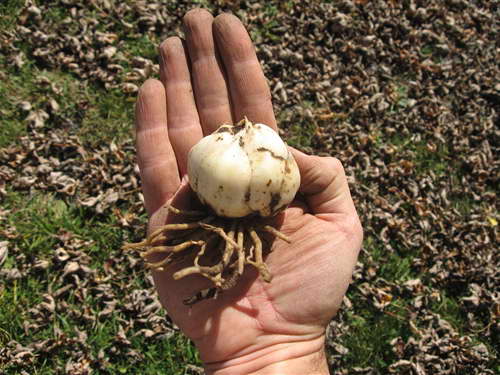

How to choose quality lily bulbs garden photo
When buying bulbs, you need to determine the variety. For example, for LA hybrids and Asian hybrids, a white bulb is characteristic, pink and yellow blotches may be present. A large yellow (less often purple) onion is an OT and oriental hybrids. For tubular lilies, purple bulbs are inherent.
Characteristics of a healthy bulb: elasticity, juiciness, no damage, signs of decay. The minimum length of live roots should be 5 cm.
In the fall, you can find a bulb with a sprout on sale - you should know: most likely, they were planted in open ground in the spring, when they are re-planted in the fall, they will immediately grow and may die from frost.
Feel free to purchase seedlings with a clod of earth, even in a blossoming state.
Features of cuttings of lilies with scales
From the school course of botany, you can recall that the scales of bulbous plants are modified leaves with a large supply of nutrients and water. That is, a separate scale is the same leaf at the base of which a small bulb can form - as at the base of a tiger lily leaf. And, unlike a green leaf, the flake will not dry out with a decrease in humidity and will not be eaten by pests. Observations have established that a bulb at the base of a scale placed in the soil can form even under conditions of periodic decrease in moisture and drying out of the soil. Therefore, this method of propagation is the best option for obtaining new lily bulbs.
The technique of reproduction of lilies with scales
It is best to separate the lily scales from the bulbs at the beginning of the growing season, before the stem begins to grow. Then they contain the largest supply of nutrients and a lot of moisture. This applies to cases where lily bulbs are not dug up for the winter and hibernate in the ground, as well as bulbs purchased for planting in the spring. If the bulb is dug out, then it is not at all difficult to separate several scales from it, you just need to break off several large scales closer to their base. They usually shrink slightly and are loosely located, acquiring sufficient mobility and are easy to break off at the very base. It is necessary to choose intact scales without drying out the tips and without signs of decay.
How to separate lily scales from a bulb
It is more difficult to separate the scales from the overwintered bulb. Firstly, you first need to carefully dig it out without damaging the roots and the scales themselves. This is easier to do if you work not only with a shovel, but with a water jet - water from a hose under a slight pressure will help you quickly get to the scales and wash out the soil accumulated between them. There is a lot of water in the lily bulb overwintered in the ground, so the scales are very dense and become very fragile. Therefore, it is very difficult to break them off at the base.Often half or even the tip breaks off. Therefore, you do not need to try to immediately break off the largest ones from the middle, but separate the lower bulbs. You can safely separate a dozen scales.
Processing lily scales before planting
The next desirable, but not required, step would be treatment of lily scales in a solution of heteroauxin. It is a root formation stimulant, which is available in the form of a solution, powder and tablets, depending on the form of release, recommendations for choosing the concentration of the solution and the duration of treatment may differ.


Method three: seeds
Many varieties of lilies have a certain box in their inflorescence, in which seeds are formed. When can you start collecting them?
It is very important to closely monitor the appearance of the plant. When the lily box becomes completely dry and turns brown, the planting material can be removed from it. It must be sown immediately into the ground or dried for further storage.


How to propagate lilies by seed? To begin with, they should be soaked in a wet cloth until the processes appear. Then the seeds are sown in the greenhouse, deepening them by no more than one centimeter.
In May, the strongest and healthiest plants can be planted in the beds, slightly shading their habitat. Fragile and weak seedlings are best left in the planting box until next spring.
Propagation by leaves


Lilies reproduce even with their leaves. The following varieties respond best to this method: Tigrovaya, Belosnezhnaya, Thunberg, Maksimovich, species: sulfur-colored and long-flowered.
Procedure
- For reproduction, you need to pluck the leaf at the tops of the stem: it is important that the leaf is separated along with the base with which it is attached to the stem.
- The leaf is then rooted obliquely, burying it 1/2 of the size into the ground. Rooting is recommended to be done in a container with the provided drainage holes. The soil should be composed of wet earth and sand.
- From above, the leaf must be covered with a polyethylene bag so that a moist, warm microclimate is formed inside. Ventilate the sheet regularly and remove any condensation that has accumulated inside the bag.
- After a month, bulbs will begin to form at the base of the leaf. At this time, the shelter is removed.
- It is better to overwinter the leaf indoors or in the garden, but under a warm shelter.
- In the following seasons, in spring or autumn, the bulbs that appear can be planted in their places.
Planting onions
If you do everything correctly, then after 1.5 - 2 months, onion babies will form on the scales. There will be up to 15 of them on one scale! Do not miss the time when the onions appear!
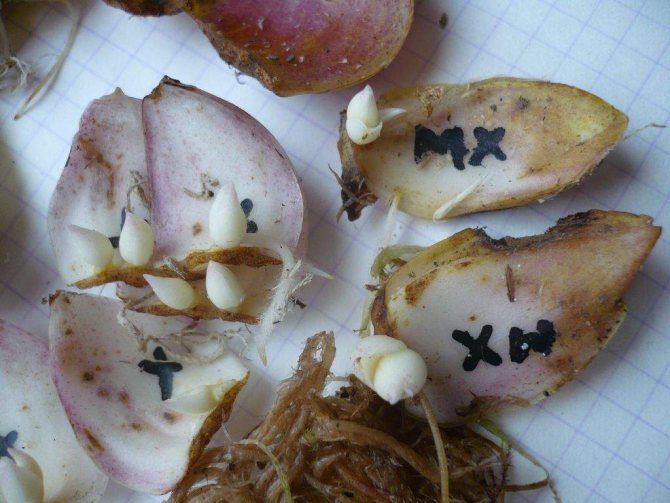

The transplant is carried out when there are no shoots yet, otherwise they will be very elongated and weak. The time is right for planting scales with onions in a regular substrate. At the stage of transplantation, the scales are food for the young onions, so they do not need to be separated yet.
It is best to prepare the substrate yourself, as a result, you will get a composition consisting of equal parts of soil, sand, peat and vermicompost. It is advisable to add vermiculite. This component promotes good plant survival and retains moisture in the soil.
The onions are planted in such a way that there is a 1 cm layer of soil above them. After planting, watering with warm water should be carefully carried out. It is better not to use cold water!
Put the box in which you planted the small onions in a bag and tie on top, but not very tightly so that air can enter there. After completing all these operations, put the box as close to the light as possible so that the emerging plants do not stretch out. Additional lighting may need to be installed.
Soon a plant will emerge from a small onion, but this is not a real lily yet. To get a full flowering plant, you need to be patient.
So, the onion also grows up and becomes more like an adult. In a year, it will grow even more, and good roots will appear on it.And in the third year after you have pinched off the scale and planted it, you will have a very beautiful blooming lily.
By propagating lilies in such an economical way, in practice, from the garbage that is often thrown away by gardeners, you can get a very large number of new plants without purchasing planting material in stores.




